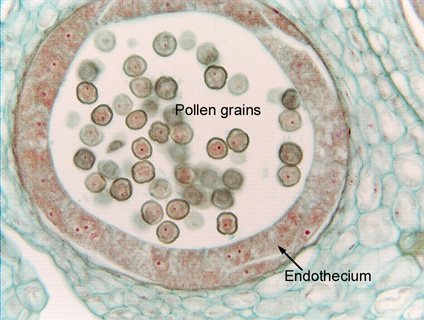Up
Oil cells
Mucilage cell, cactus
Mucilage cell, Opuntia
Non-articulated laticifer
Spurge laticifer
Laticifers
Articulated laticifers
Stinging nettle
Ducts, low mag
Duct, mag.
Wormwood duct
Young duct
Pine duct
Pine needles
Hemlock leaf
Citrus oil gland
Cotton duct
Anther endothecium
Hydathode
Glandular trichome
Venus' flytrap
Sweet olive
Sundew
| |
 Fig.
9.3-9. Transverse section of stamen in lemon flower (Citrus limon).
This is a transverse section of the anther, the part of the stamen that actually
produces the pollen grains. As part of pollen development, the cells lining the anther lumen – a layer
known as the endothecium – secretes materials that are essential for the
proper maturation of the pollen grains. In many cases, secretory
processes in plants involve interaction with animals (deterring herbivores or
attracting pollinators), but in processes like this in the anther, the secretion
is a mechanism by which one part of a plant affects another part of the same
plant. Fig.
9.3-9. Transverse section of stamen in lemon flower (Citrus limon).
This is a transverse section of the anther, the part of the stamen that actually
produces the pollen grains. As part of pollen development, the cells lining the anther lumen – a layer
known as the endothecium – secretes materials that are essential for the
proper maturation of the pollen grains. In many cases, secretory
processes in plants involve interaction with animals (deterring herbivores or
attracting pollinators), but in processes like this in the anther, the secretion
is a mechanism by which one part of a plant affects another part of the same
plant.
The cells of the endothecium are so densely cytoplasmic that no vacuoles
at all are visible; it is even difficult to distinguish one cell from another in
most of the endothecium. The dark red dots in the both the endothecium and the
pollen grains are nucleoli, with the actual nuclei being just barely visible
around a few of them (all nucleoli occur only in nuclei – where we cannot see
the nuclei, it is due to weak staining).
|
 Fig.
9.3-9. Transverse section of stamen in lemon flower (Citrus limon).
This is a transverse section of the anther, the part of the stamen that actually
produces the pollen grains. As part of pollen development, the cells lining the anther lumen – a layer
known as the endothecium – secretes materials that are essential for the
proper maturation of the pollen grains. In many cases, secretory
processes in plants involve interaction with animals (deterring herbivores or
attracting pollinators), but in processes like this in the anther, the secretion
is a mechanism by which one part of a plant affects another part of the same
plant.
Fig.
9.3-9. Transverse section of stamen in lemon flower (Citrus limon).
This is a transverse section of the anther, the part of the stamen that actually
produces the pollen grains. As part of pollen development, the cells lining the anther lumen – a layer
known as the endothecium – secretes materials that are essential for the
proper maturation of the pollen grains. In many cases, secretory
processes in plants involve interaction with animals (deterring herbivores or
attracting pollinators), but in processes like this in the anther, the secretion
is a mechanism by which one part of a plant affects another part of the same
plant.